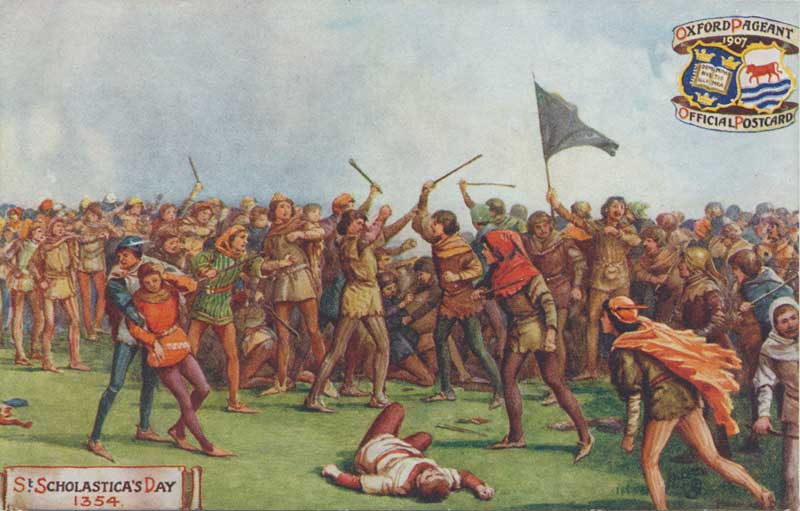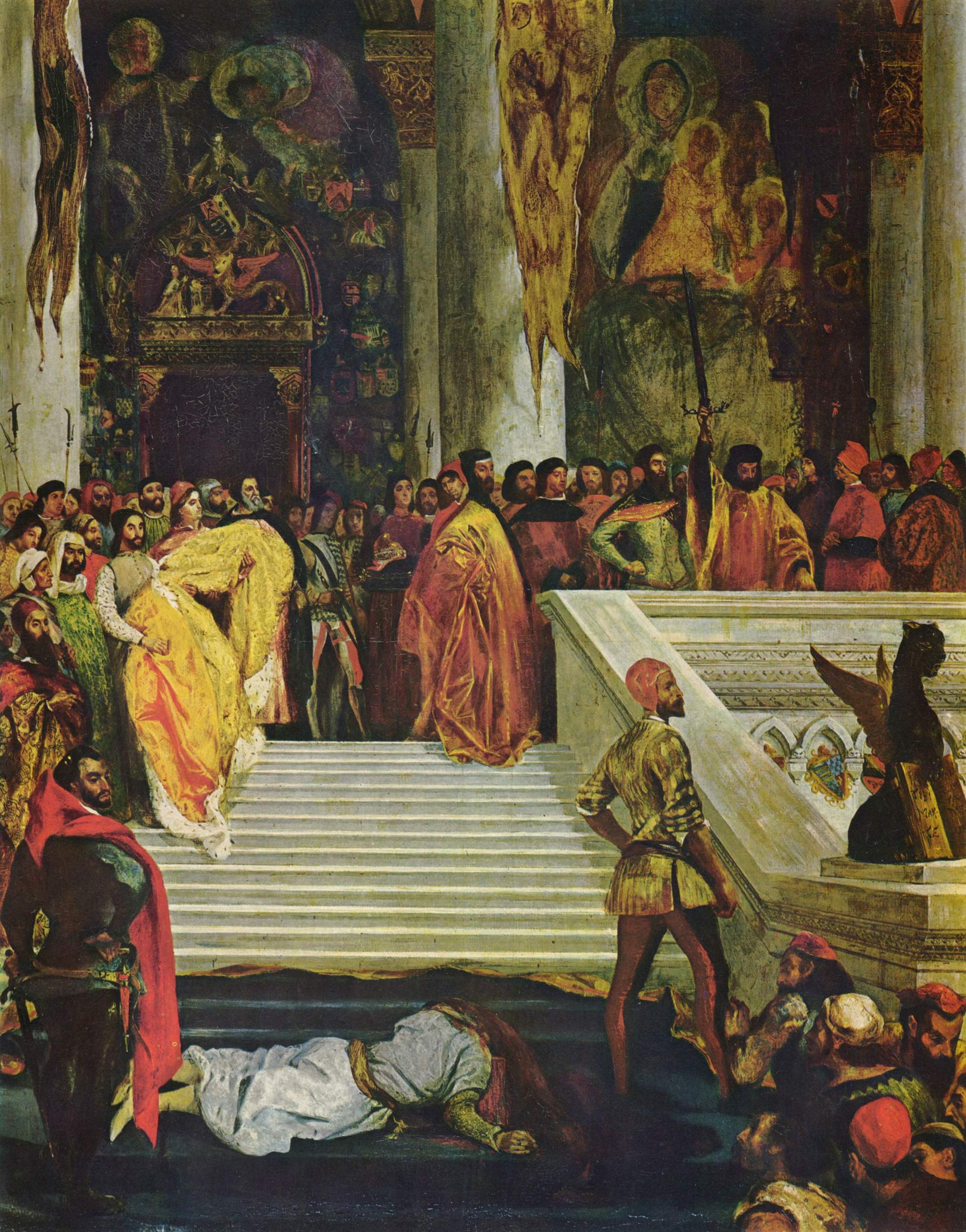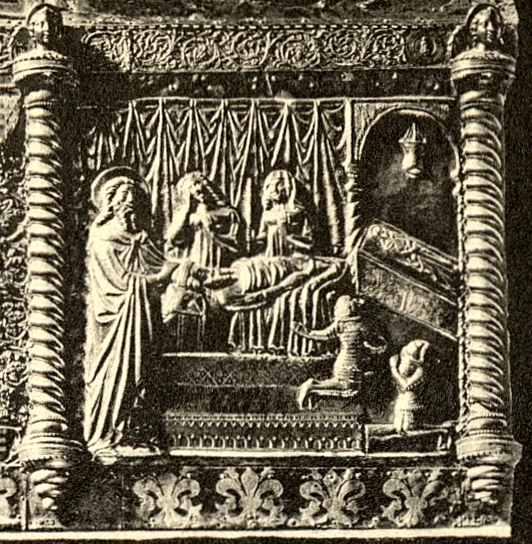|
1355
Year 1355 ( MCCCLV) was a common year starting on Thursday (link will display the full calendar) of the Julian calendar. Events * January 6 – Charles IV of Bohemia is crowned with the Iron Crown of Lombardy as King of Italy in Milan. * January 7 – King Alphonso IV of Portugal sends three men who kill Inês de Castro, beloved of his son Peter, who revolts and incites a civil war. * February 10 – St Scholastica Day riot in Oxford, England, breaks out, leaving 63 scholars and perhaps 30 locals dead in two days. * April – Philip II, Prince of Taranto, marries Maria of Calabria, daughter of Charles, Duke of Calabria, and Marie of Valois. * April 5 – Charles IV is crowned Holy Roman Emperor in Rome. * April 18 – In Venice, the Council of Ten beheads Doge Marin Falier, for conspiring to kill them. * August – Battle of Nesbit Moor: The Scottish army decisively defeats the English. * September 1 – The old town of Visoki is first men ... [...More Info...] [...Related Items...] OR: [Wikipedia] [Google] [Baidu] |
St Scholastica Day Riot
The St Scholastica Day riot took place in Oxford, England, on 10 February 1355, Saint Scholastica's Day. The disturbance began when two students from the University of Oxford complained about the quality of wine served to them in the Swindlestock Tavern, which stood on Carfax, in the centre of the town. The students quarrelled with the taverner; the argument quickly escalated to blows. The inn's customers joined in on both sides, and the resulting melee turned into a riot. The violence started by the bar brawl continued over three days, with armed gangs coming in from the countryside to assist the townspeople. University halls and students' accommodation were raided and the inhabitants murdered; there were some reports of clerics being scalped. Around 30 townsfolk were killed, as were up to 63 members of the university. Violent disagreements between townspeople and students had arisen several times previously, and 12 of the 29 coroners' courts held in Oxford between 1297 and ... [...More Info...] [...Related Items...] OR: [Wikipedia] [Google] [Baidu] |
Charles IV, Holy Roman Emperor
Charles IV ( cs, Karel IV.; german: Karl IV.; la, Carolus IV; 14 May 1316 – 29 November 1378''Karl IV''. In: (1960): ''Geschichte in Gestalten'' (''History in figures''), vol. 2: ''F–K''. 38, Frankfurt 1963, p. 294), also known as Charles of Luxembourg, born Wenceslaus (, ), was the first King of Bohemia to become Holy Roman Emperor. He was a member of the House of Luxembourg from his father's side and the Bohemian House of Přemyslid from his mother's side; he emphasized the latter due to his lifelong affinity for the Bohemian side of his inheritance, and also because his direct ancestors in the Přemyslid line included two saints. He was the eldest son and heir of John of Bohemia, King of Bohemia and Count of Luxembourg, who died at the Battle of Crécy on 26 August 1346. His mother, Elizabeth, Queen of Bohemia, was the sister of Wenceslaus III, King of Bohemia and Poland, the last of the male Přemyslid rulers of Bohemia. Charles inherited the County of Luxemb ... [...More Info...] [...Related Items...] OR: [Wikipedia] [Google] [Baidu] |
Charles IV Of Bohemia
Charles IV ( cs, Karel IV.; german: Karl IV.; la, Carolus IV; 14 May 1316 – 29 November 1378''Karl IV''. In: (1960): ''Geschichte in Gestalten'' (''History in figures''), vol. 2: ''F–K''. 38, Frankfurt 1963, p. 294), also known as Charles of Luxembourg, born Wenceslaus (, ), was the first King of Bohemia to become Holy Roman Emperor. He was a member of the House of Luxembourg from his father's side and the Bohemian House of Přemyslid from his mother's side; he emphasized the latter due to his lifelong affinity for the Bohemian side of his inheritance, and also because his direct ancestors in the Přemyslid line included two saints. He was the eldest son and heir of John of Bohemia, King of Bohemia and Count of Luxembourg, who died at the Battle of Crécy on 26 August 1346. His mother, Elizabeth, Queen of Bohemia, was the sister of Wenceslaus III, King of Bohemia and Poland, the last of the male Přemyslid rulers of Bohemia. Charles inherited the County of Luxemb ... [...More Info...] [...Related Items...] OR: [Wikipedia] [Google] [Baidu] |
Marin Falier
Marino Faliero (1274 – 17 April 1355) was the 55th Doge of Venice, appointed on 11 September 1354. He was sometimes referred to simply as Marin Falier ( Venetian rather than standard Italian) or Falieri. He was executed for attempting a coup d'etat. Early life Faliero was the son of Iacopo Marin and Beriola Loredan. He had an uncle of the same name with whom he is often confused. In 1315 Faliero was one of the three heads of the Council of Ten when it was punishing the organizers of the 1310 conspiracy by Bajamonte Tiepolo. Faliero continued as a member of the council until 1320 and held the office of chief and inquisitor several times. In 1320 he was charged with Andrea Michiel to organize the killing of Tiepolo and Pietro Querini, the only two leaders of the conspiracy still at large. In 1323 Faliero was appointed captain and bailiff of Negroponte. In 1326 he was again in Venice as a member of the Council of Ten, but the following year he left for Bologna on a mission t ... [...More Info...] [...Related Items...] OR: [Wikipedia] [Google] [Baidu] |
Battle Of Nesbit Moor (1355)
The Battle of Nesbit Moor was an engagement fought in August 1355 between forces of the Kingdom of Scotland and the Kingdom of England. Background Hostilities broke out in early 1355, following the end of a truce, and the breakdown of negotiations for the release of David II from English captivity. Immediately after the end of the truce, the English raided Scotland and burnt the lands of Patrick V, Earl of March. Raid at Norham The Earl of March in retaliation, with William, Lord of Douglas, with their contingents, supplemented by a force of sixty French knights marched to the Merse in August. Douglas sent Sir William Ramsay of Dalhousie, and a force of men to despoliate and raid the country around Norham Castle, captained by Sir Thomas Grey. Douglas' ploy was to encourage Grey into an ambush. Ramsay called on Grey and his garrison to come out of the castle and fight them. Grey, suspicious of other marauding Scots forces, sent scouts to look for evidence of them, but kept ... [...More Info...] [...Related Items...] OR: [Wikipedia] [Google] [Baidu] |
Peter I Of Portugal
Peter I (Portuguese: ''Pedro I'', ; 8 April 1320 – 18 January 1367), called the Just (''o Justiceiro'') or the Cruel (''o Cruel''), was King of Portugal from 1357 until his death. He was the third but only surviving son of Afonso IV of Portugal and his wife, Beatrice of Castile. Early life In 1328, Peter's father, Afonso IV arranged for the marriage of his eldest daughter, Maria, to Alfonso XI of Castile. However, soon after their marriage Alfonso began a long affair with the beautiful and newly widowed Leonor de Guzman. Maria bore Alfonso a son in 1334, who ultimately became Peter of Castile, but after the Castilian king refused to end his affair Maria returned home to Portugal in 1335. Alfonso had been married once before, to his cousin's daughter, Constanza Manuel (granddaughter of James II of Aragon). Alfonso had the marriage annulled in 1327, after only two years, to clear the way for marriage to Maria. This angered his cousin Juan Manuel, Prince of Villena, a powerful ... [...More Info...] [...Related Items...] OR: [Wikipedia] [Google] [Baidu] |
Old Town Of Visoki
The Old town of Visoki ( sh-Latn-Cyrl, Stari grad Visoki, Стари град Високи, ) was a medieval royal castle town built during the 14th century on the top of the hill overlooking town of Visoko, Bosnia and Herzegovina. The first mention of the town was on 1 September 1355, in the charter "''in castro nosto Visoka vocatum''" written by Tvrtko I of Bosnia while he was a young ban. The town was presumably abandoned before 1503, as it is not mentioned in the Turkish-Hungarian treaty from the mentioned year. In 1626, Đorđić mentioned Visoki among abandoned towns. Location and size The Old Town of Visoki is at the top of Visočica hill, high. Its position provides an excellent view at the plains below. The entry to the castle is on the southwest side, with two lookout towers. Passing through the entry you enter a part that is called ''Podvisoki'', which was quite small, measuring and has signs and remains of early medieval houses. The thickness of the castle town w ... [...More Info...] [...Related Items...] OR: [Wikipedia] [Google] [Baidu] |
Inês De Castro
Inês de Castro (; in Castilian: Inés; 1325 – 7 January 1355) was a Galician noblewoman and courtier, best known as lover and posthumously-recognized wife of King Peter I of Portugal. The dramatic circumstances of her relationship with Peter (at the time Prince of Portugal), which was forbidden by his father King Afonso IV, her murder at the orders of Afonso, Peter's bloody revenge on her killers, and the legend of the coronation of her exhumed corpse by Peter, have made Inês de Castro a frequent subject of art, music, and drama through the ages. Biography Inês was the natural daughter of Pedro Fernández de Castro, Lord of Lemos and Sarria, and his noble Portuguese mistress Aldonça Lourenço de Valadares. Her family descended both from the Galician and Portuguese nobilities. She was also well connected to the Castilian royal family, by illegitimate descent. Her stepmother was Infanta Beatrix of Portugal, the youngest daughter of Afonso of Portugal, Lord of Portalegre and V ... [...More Info...] [...Related Items...] OR: [Wikipedia] [Google] [Baidu] |
Tvrtko I Of Bosnia
Stephen Tvrtko I ( sh-Latn-Cyrl, separator=" / ", Stjepan/Stefan Tvrtko, Стјепан/Стефан Твртко; 1338 – 10 March 1391) was the first king of Bosnia. A member of the House of Kotromanić, he succeeded his uncle Stephen II as Ban of Bosnia in 1353. As he was a minor at the time, Tvrtko's father, Vladislav, briefly ruled as regent, followed by Tvrtko's mother, Jelena. Early in his personal rule, Tvrtko quarreled with his country's Roman Catholic clergy, but later enjoyed cordial relations with all the religious communities in his realm. After initial difficulties – the loss of large parts of Bosnia to his overlord, King Louis I of Hungary, and being briefly deposed by his magnates – Tvrtko's power grew considerably. He conquered some remnants of the neighbouring Serbian Empire in 1373, after the death of its last ruler and his distant relative, Uroš the Weak. In 1377, he had himself crowned king of Bosnia and of Serbia, claiming to be the heir of Serbia' ... [...More Info...] [...Related Items...] OR: [Wikipedia] [Google] [Baidu] |
Maria Of Calabria
Maria of Calabria (6 May 1329 – 20 May 1366), Countess of Alba, was a Neapolitan princess of the Capetian House of Anjou whose descendants inherited the crown of Naples following the death of her older sister, Queen Joanna I. Life Early years Maria was the fifth and posthumous child of Charles, Duke of Calabria (eldest son of King Robert the Wise of Naples) and Marie of Valois (half-sister of King Philip VI of France). She was born approximately six months following her father's death, on 9 November 1328. At the time of her birth, from her older three sisters and one brother, only her sister Joanna, born in March 1325, was alive. Two years later, on 23 October 1331, Maria's mother Marie of Valois died during a pilgrimage to Bari, leaving Maria and her older sister Joanna (now heiress of the throne of Naples) orphans. Both were raised at the court of their paternal grandfather King Robert in Naples. By a bull dated on 30 June 1332, Pope John XXII officially decreed that ... [...More Info...] [...Related Items...] OR: [Wikipedia] [Google] [Baidu] |
January 7
Events Pre-1600 *49 BC – The Senate of Rome says that Caesar will be declared a public enemy unless he disbands his army. This prompts the tribunes who support him to flee to Ravenna, where Caesar is waiting. * 1325 – Alfonso IV becomes King of Portugal. * 1558 – French troops, led by Francis, Duke of Guise, take Calais, the last continental possession of England. 1601–1900 *1608 – Fire destroys Jamestown, Virginia. * 1610 – Galileo Galilei makes his first observation of the four Galilean moons: Ganymede, Callisto, Io and Europa, although he is not able to distinguish the last two until the following day. * 1738 – A peace treaty is signed between Peshwa Bajirao and Jai Singh II following Maratha victory in the Battle of Bhopal. * 1782 – The first American commercial bank, the Bank of North America, opens. * 1785 – Frenchman Jean-Pierre Blanchard and American John Jeffries travel from Dover, England, to Calais, France, in a ... [...More Info...] [...Related Items...] OR: [Wikipedia] [Google] [Baidu] |
February 10
Events Pre-1600 * 1258 – Mongol invasions: Baghdad falls to the Mongols, bringing the Islamic Golden Age to an end. * 1306 – In front of the high altar of Greyfriars Church in Dumfries, Robert the Bruce murders John Comyn, sparking the revolution in the Wars of Scottish Independence. * 1355 – The St Scholastica Day riot breaks out in Oxford, England, leaving 63 scholars and perhaps 30 locals dead in two days. *1502 – Vasco da Gama sets sail from Lisbon, Portugal, on his second voyage to India. * 1567 – Lord Darnley, second husband of Mary, Queen of Scots, is found strangled following an explosion at the Kirk o' Field house in Edinburgh, Scotland, a suspected assassination. 1601–1900 * 1712 – Huilliches in Chiloé rebel against Spanish encomenderos. * 1763 – French and Indian War: The Treaty of Paris ends the war and France cedes Quebec to Great Britain. * 1814 – Napoleonic Wars: The Battle of Champaubert ends in French victo ... [...More Info...] [...Related Items...] OR: [Wikipedia] [Google] [Baidu] |



